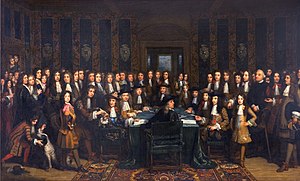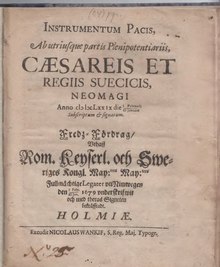Treaties of Nijmegen
| Traités de Paix de Nimègue (French) | |
|---|---|
 Dutch and French diplomats signing the peace treaty | |
| Context | Franco-Dutch War: Franco-Dutch War end; France control Franche-Comté, select Flanders cities, and Hainaut. |
| Signed | 1678–79 |
| Location | Nijmegen, Dutch Republic |
| Parties | |
The Treaties of Peace of Nijmegen (French: Traités de Paix de Nimègue; German: Friede von Nimwegen; Dutch: Vrede van Nijmegen) were a series of treaties signed in the Dutch city of Nijmegen between August 1678 and October 1679. The treaties ended various interconnected wars among France, the Dutch Republic, Spain, Brandenburg, Sweden, Denmark-Norway, the Prince-Bishopric of Münster, and the Holy Roman Empire. The most significant of the treaties was the first, which established peace between France and the Dutch Republic and placed the northern border of France very near its modern position.[1]
Background
[edit]The Franco-Dutch War of 1672–78 was the source of all the other wars that were ended formally at Nijmegen. Separate peace treaties were arranged for conflicts like the Third Anglo-Dutch War and the Scanian War, but all of them had been directly caused by and form part of the Franco-Dutch War. England initially participated in the war on the French side but withdrew in 1674, after the Treaty of Westminster. The Electorate of Cologne left the war in 1674, while the Prince-Bishopric of Münster switched sides from France to join the anti-French coalition that year. Denmark-Norway also joined the anti-French side in 1675, primarily fighting against Sweden.[citation needed]
At the end of the Franco-Dutch and Scanian Wars, these were the belligerents:
- Anti-French coalition
- France and allies
Treaties
[edit]Peace negotiations had begun as early as 1676, but nothing was agreed to and signed before 1678. Most treaties were concluded in Nijmegen, therefore the sum of all documents is known as the 'Treaties of Nijmegen'. Some of the countries involved signed peace deals elsewhere, such as the Treaty of Celle (Sweden made peace with Lüneburg (Celle)), Treaty of Saint-Germain (France and Sweden made peace with Brandenburg) and Treaty of Fontainebleau (France dictated peace between Sweden and Denmark-Norway).[citation needed]
| Treaties of Nijmegen and related treaties | |||||
|---|---|---|---|---|---|
| Date (New Style / (Old Style)) | Treaty | Anti-French side | French side | Text | Refs |
| 10 August 1678 | Treaty of Nijmegen | Dutch Republic | France | Dutch | [2][3] |
| 10 August 1678 | (separate trade treaty) | Dutch Republic | France | [4] | |
| 17 September 1678 | Treaty of Nijmegen | Spain | France | French | [2] |
| 5 February 1679 | Treaty of Nijmegen | Holy Roman Empire | France and Sweden | Latin/Swedish, German | [2] |
| 5 February 1679 (26 January 1679) | Treaty of Celle | Lüneburg (Celle) | Sweden (and France) | [5] | |
| 19 March 1679 | Treaty of Nijmegen | Münster | Sweden | [6][7] | |
| 29 June 1679 (19 June 1679) | Treaty of Saint-Germain | Brandenburg-Prussia | France (and Sweden) | [2] | |
| 2 September 1679 (23 August 1679) | Treaty of Fontainebleau | Denmark-Norway | Sweden (and France) | [2] | |
| 26 September 1679 (16 September 1679) | Peace of Lund | Denmark-Norway | Sweden (and France) | [2] | |
| 12 October 1679 (2 October 1679) | Treaty of Nijmegen | Dutch Republic | Sweden | [2] | |
Terms
[edit]This section relies largely or entirely on a single source. (November 2021) |

The Franco–Dutch War ended with a treaty which gave France control over the region of the Franche-Comté.[8] France also gained further territories of the Spanish Netherlands, adding to those it had annexed under the 1659 Treaty of the Pyrenees and 1668 Treaty of Aix-la-Chapelle. These included the town of Saint-Omer with the remaining northwestern part of the former Imperial County of Artois; the lands of Cassel, Aire and Ypres in southwestern Flanders; the Bishopric of Cambrai; and the towns of Valenciennes and Maubeuge in the southern County of Hainaut.[citation needed]
In turn, French King Louis XIV ceded the occupied town of Maastricht and the Principality of Orange to the Dutch stadtholder William III. The French forces withdrew from several occupied territories in northern Flanders and Hainaut.[citation needed]
Emperor Leopold I retained the captured fortress of Philippsburg but had to accept the French occupation of the towns of Freiburg (until 1697) and Kehl (until 1698) on the right bank of the Rhine.[citation needed]
The treaties did not result in a lasting peace.[citation needed]
Culture
[edit]Marc-Antoine Charpentier wrote a Te Deum for this occasion. The prelude of the Te Deum is also known as the Eurovision theme.
See also
[edit]References
[edit]- ^ Nolan, Cathal J (2008). Wars of the age of Louis XIV, 1650–1715. ABC-CLIO. p. 128. ISBN 978-0-313-33046-9.
- ^ a b c d e f g Verzijl, J. H. W. (1973). International Law in Historical Perspective, Volume 6. Leiden: A. W. Sijthoff. p. 143. ISBN 9789028602236. Retrieved 15 August 2020.
- ^ Sweden was not part of the treaty, but a section forces the Dutch Republic to take a neutral approach toward Sweden with which it had been at war since 1675.
- ^ France and the Dutch Republic signed this separate treaty on commerce and navigation, set to expire after 25 years, on the same day in Nijmegen.
- ^ Dyer, Thomas Henry (1864). The History of Modern Europe from the Fall of Constantinople in 1453, to the War in the Crimea, in 1857. London: John Murray. p. 126.
- ^ "History". Treaties of Nijmegen Medal. 2010. Archived from the original on 30 December 2020. Retrieved 15 August 2020.
- ^ All of Münster's soldiers in Danish war service were to be withdrawn.
- ^ Horne, Alistair (2004). La Belle France. Vintage. p. 164. ISBN 978-1-4000-3487-1.
External links
[edit]- 1678 treaties
- 1679 treaties
- 1678 in Europe
- 1679 in Europe
- Peace treaties of the Ancien Régime
- Peace treaties of the Dutch Republic
- Peace treaties of Spain
- Peace treaties of Denmark
- Treaties of the Holy Roman Empire
- Treaties of the Swedish Empire
- Treaties of the Margraviate of Brandenburg
- Treaties of the Spanish Empire
- 1678 in the Dutch Republic
- 1679 in the Dutch Republic
- 1678 in France
- 1679 in France
- 1678 in Spain
- 1679 in Sweden
- 1678 in the Holy Roman Empire
- 1679 in the Holy Roman Empire
- History of Nijmegen
- Leopold I, Holy Roman Emperor
- Louis XIV
- William III of England
- Franco-Dutch War
